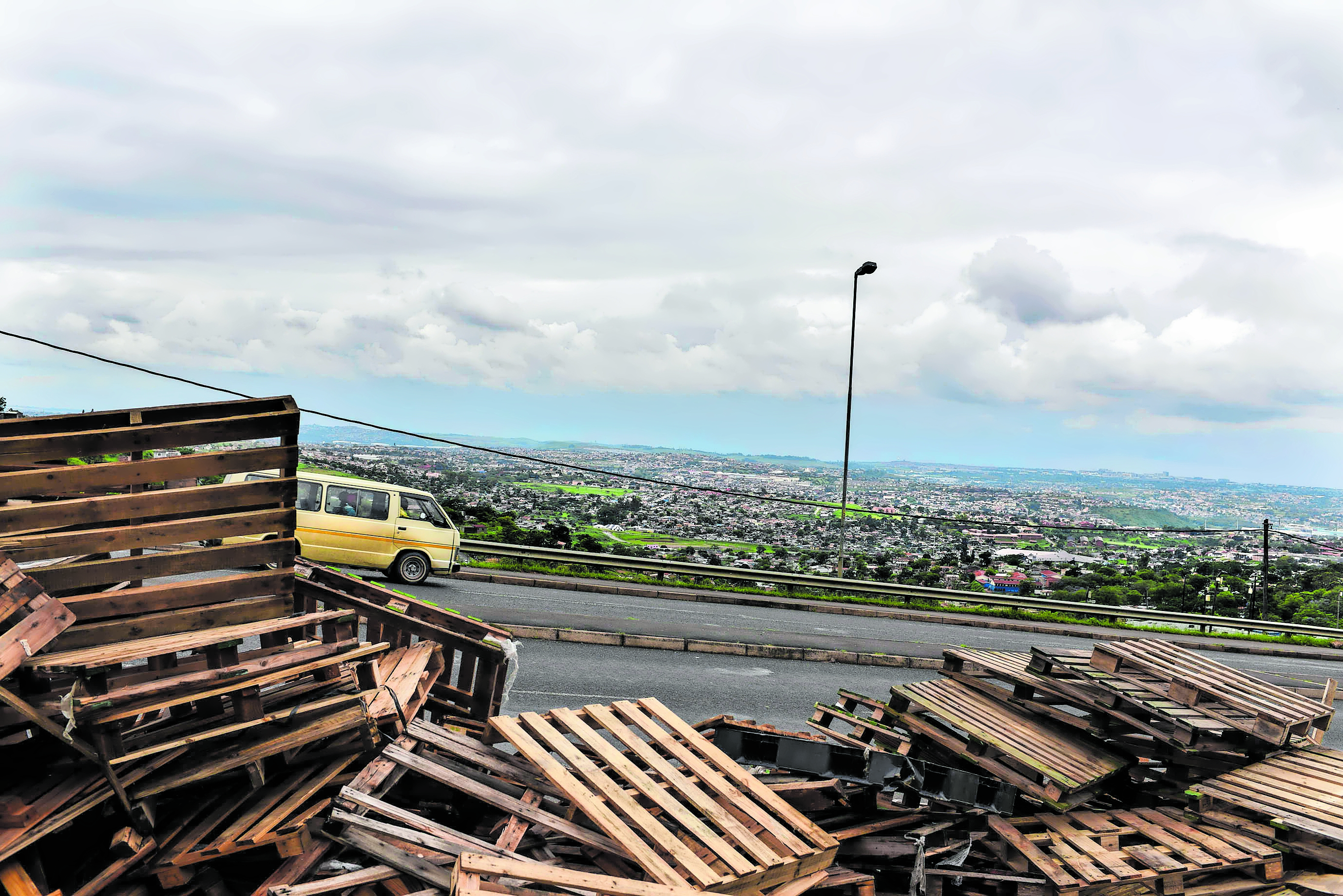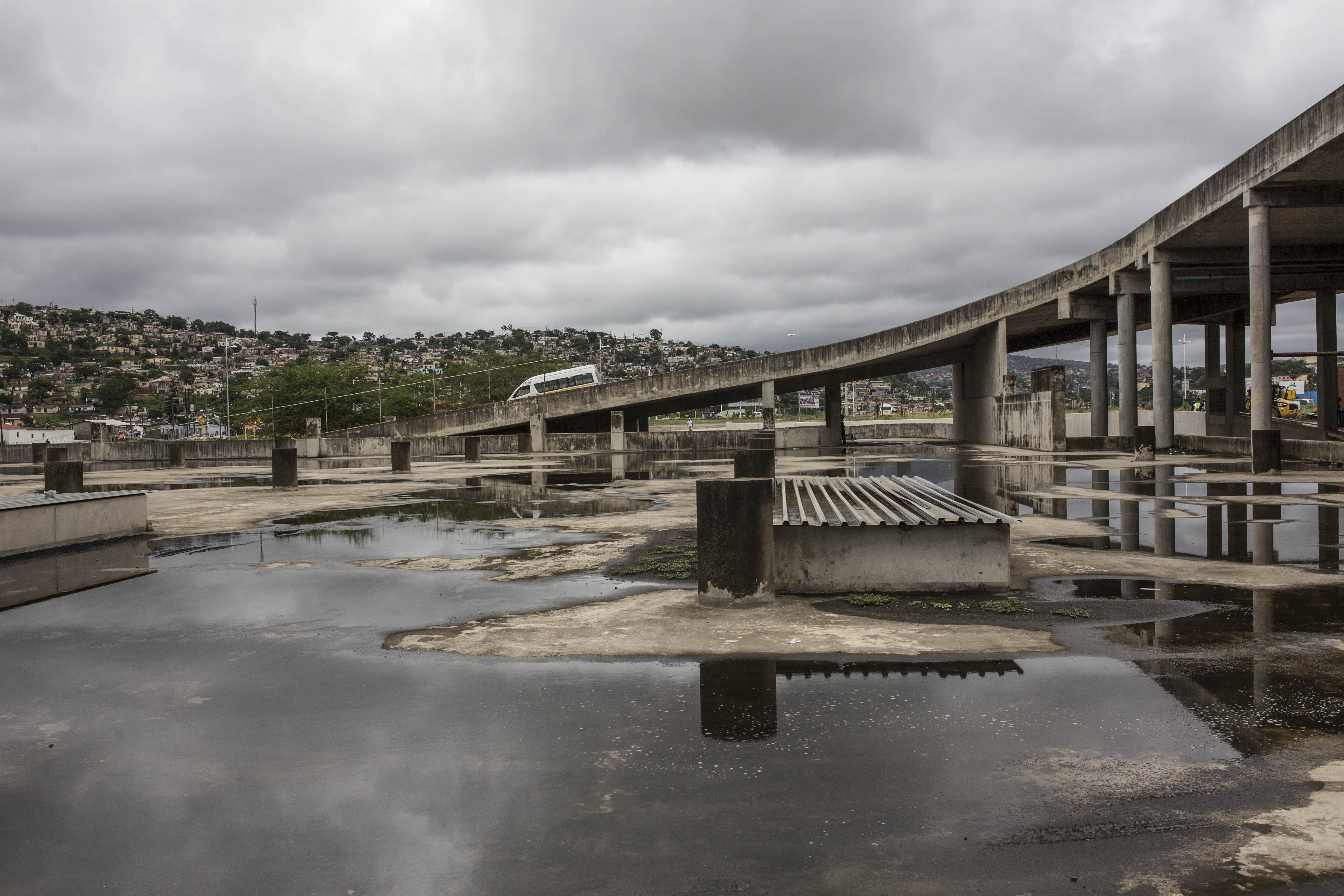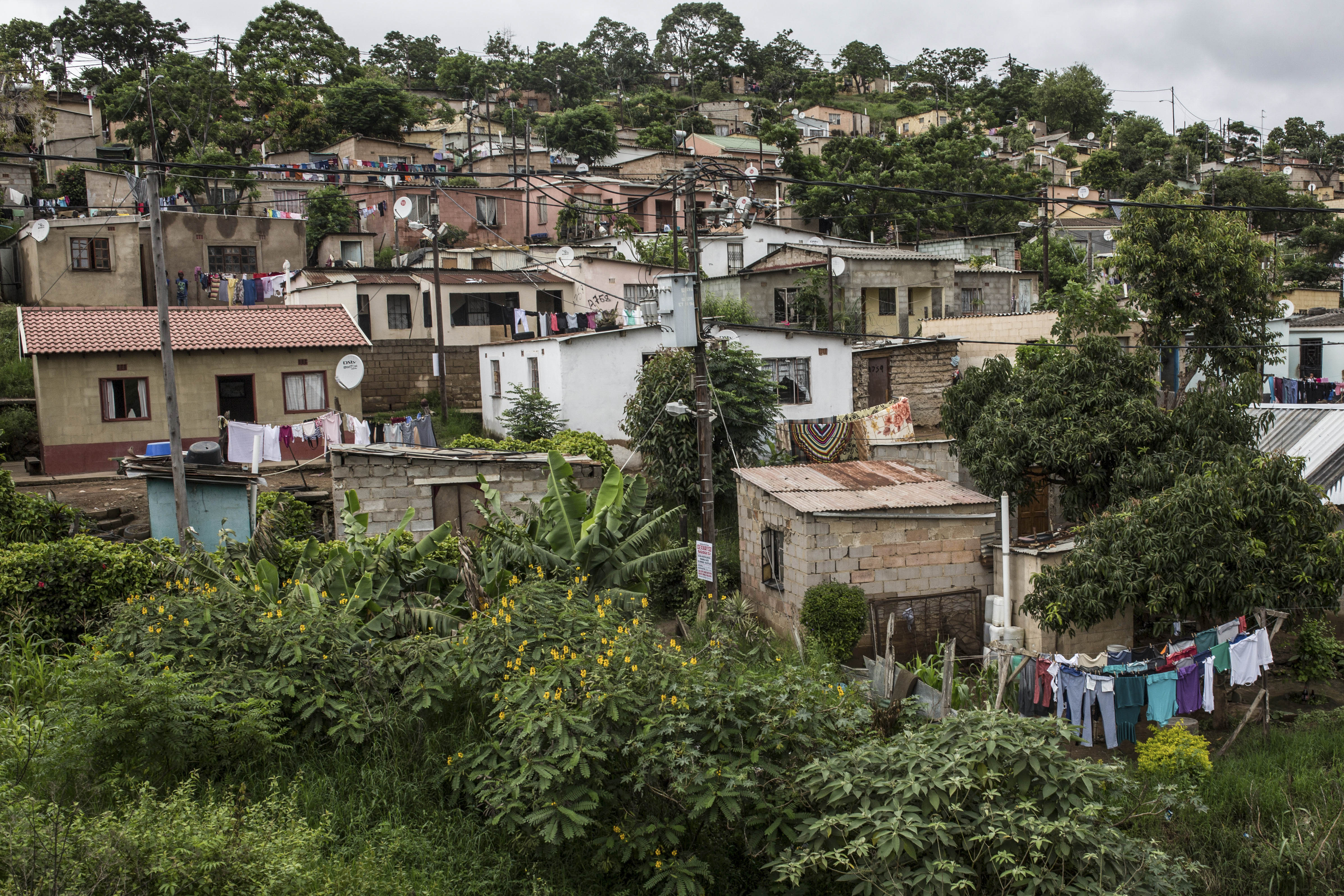In Durban, the rapid expansion of the city’s roads creates many invisible boundaries. The large, newly completed flyovers and highways rebrand the city as one that efficiently transports its labour force.
As you go towards the north-western township of KwaMashu on the new Queen Nandi Drive, some of these new roads criss-cross each other, creating a stark picture of a “progress” without structural overhaul.
Travelling north on the M25 towards Inanda, the widened road acts as a dividing line between the townships of KwaMashu, Ntuzuma and Inanda, banishing them to a hilly, northwesterly boundary — while partially hiding Phoenix behind a wall of factories. The boundaries, to an extent, are shifting, with Dube Village signalling an expansion of black townships into racialised buffer zones.
By contrast, eNgcongcweni, less than 10km north of Dube Village, is an inhabited area devoid of the grid-like purposefulness of (post-)apartheid planning.
“There were no tarred roads or electricity here,” says Maletho Mkhunya, 32, who was raised in the settlement.
“Siyakhula, a parent-led organisation, fought for those services here in the Nineties. Maybe before ’95 or ’96 or even before that.”
The larger surrounding area, built on land that was once allocated to missionaries, had a middle-class, intellectual character. “So here, things have changed with the arrival of more people. That sense of community has dissipated. There are a lot of outsiders and interrelations with those outsiders.”
By “outsiders” Mkhunya means anyone considered a migrant, who speaks a language other than isiZulu. Mkhunya believes that the building of rental “cottages” has had a profound effect on the quality of life in eNgcongcweni.
“They build them as standalone structures. They [the cottages] bring a lot of outsiders with them. In some cases, a lot of young people live there who approach life differently and that results in a lot of negative influences.”
There were many teachers who were into cultural events, he says. “They would do amahlahla around December. Amahlahla were like celebrations involving presents and so on. But that hardly happens any more. There were stage plays and all that. Boys and girls would throw beauty contests and so on. They would dance and do sketch theatre like they would do in Sarafina.”
Mkhunya, a primary school principal’s son, has a rap career he is enthusiastic about. He reaches over from the back seat, from where he has been giving me directions, and sticks a USB into the port. He raps in English and slang based in isiZulu, to scabrous, trap-influenced, hip-hop beats. Except for some testosterone-fuelled declarations of greatness, I make neither head nor tail of it.
He takes me to a friend’s father, Lucky Mchunu — not his real name — a politically connected man.

[Expansion: A pallete business to build homes thrives near Dube Village, a newly formalised township. Population growth puts a strain on services. (Paul Botes)]
“These are people living on the king’s land, Ingonyama Trust, basically,” Mchunu says. He is in the lounge of his home, which is at the top of eNgcongcweni, where you can see the Valley of a Thousand Hills stretching out to the horizon. What was pastoral land is becoming an organic township, a “skomplaas”, as Mkhunya calls it.
“And when the people talk of title deeds, it rubs the authorities the wrong way.”
He talks about the place’s fading peri-urban characteristics, “like how you could scold a neighbour’s child and they would oblige”.
He also agrees that the cottages have altered the tenor of life here. “If the landlords could be registered as entrepreneurs and taxed, that might control the proliferation of cottages.
“The fact that most people can be termed subjects of the king shows in the lagging development,” Mchunu says. “It’s still like the Bantustans; there is development but, largely, it hasn’t arrived.”
Mchunu says the youths used to play football and that kept the children manageable. “Now they smoke whoonga and so on.”

[Links: New roads and flyovers connect disparate parts of the city, but they criss-cross vastly unequal pockets (Matt Kay)]
Not far from Mchunu’s yard is a retired mechanic, Nhlanhla Msomi. Born in 1961, long before the scourge of whoonga, Msomi was 30 years old before they got electricity in their home. They fought hard for it. “Back then you had to be well-to-do to get electricity,” he says.
He is seated in his lounge. A kiddie’s programme beams an in-studio performance by a gqom troupe. His wife is curled up on the sofa, watching the performance.
“We were used to it,” he says of life without electricity. “Things did improve but we still did not have water. Even now, the water is no longer functioning properly because there are a lot of houses. And the pipes I guess are too small to support the number of dwellings. Now they must beef up the infrastructure. We have a tap in the yard but sometimes there is no water. So we mostly depend on the truck, which comes twice or three times a week and we gather around it.”
Despite the backward movement as far as water is concerned, Msomi says some of the human traffic into the area includes people fed up with the expense of suburban life: “It is because there they are paying rates.”
“This has been a trend since there was development in the place but of late we have been having water problems because of the number of people. There are roads that have been earmarked for refurbishment. And the very things that were pushing people to go to the suburbs were roads, electricity and water.”
A few kilometres away in an old but neat house where his grandfather once lived (there is a portrait of him in a three-piece suit on a pink wall), Zakes Makhanya speaks in the romantic tones of a former combatant, disappointed with his organisation but proud of his role.
“As comrades, there was a lot that we wanted to see happen,” says Makhanya, a 1985-generation exile. “They built houses in Congo [a neighbourhood of Inanda] and eMaplazini [another in-situ development] adjacent to Inanda Seminary but here it is still a mission. It went back to the king. Here they just came with toilets. Why would you start with a toilet?”
Here, in the land where politically rolled-out housing sounded the death knell of the Inkatha Freedom Party (IFP) and secured converts for the ANC, Makhanya says: “Now it’s actually a disadvantage that you were a guerrilla, because some of the people calling shots now in the local structures of ANC weren’t participating anywhere politically. That creates a culture of ubumbaxambili [apolitical schizophrenia], which makes it difficult to build organisational unity. We won over the IFP, so their former members bring that element to things. It’s like if you represent the organisation from exile, you are a problem.”

[Many parts of Durban got in situ development, which did not alleviate congestion brought on by rapid urbanisation. (Matt Kay)]
Makhanya believes that the political peace they fought so hard to preserve in parts of Inanda during the lead-up to 1994 will be undone by the double bind that is their lives: rapid urbanisation under feudal laws.